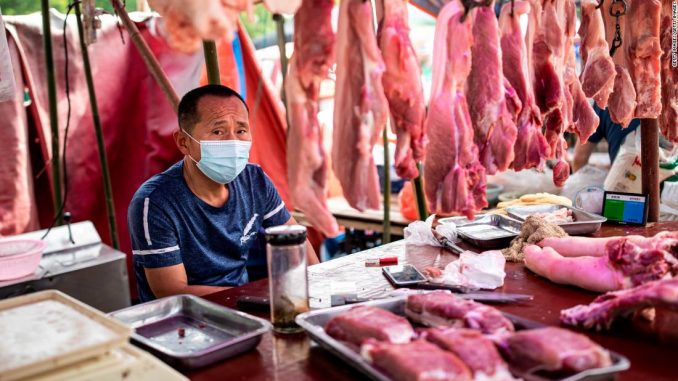Advertisement

The researchers found that the earliest Covid-19 cases were concentrated in the marketplace, among vendors selling these live animals or among people shopping there. They believe that two different viruses were circulating in the animals, which then spread to humans.
“All eight COVID-19 cases detected before December 20 were from the west side of the market, where mammalian species were also sold,” the study said. The proximity to five stalls selling live or recently slaughtered animals was indicative of human cases.
“The clustering is very, very specific,” study co-author Kristian Andersen, a professor in the Department of Immunology and Microbiology at Scripps Research, said Tuesday.
The “extraordinary” pattern that emerged from the mapping of these cases was very clear, said another co-author, Michael Worobey, department head of ecology and evolutionary biology at the University of Arizona.
The researchers mapped the earliest cases that had no connection to the market, Worobey noted, and those people lived or worked in close proximity to the market.
“This is an indication that the virus spread among people working in the market, but then spread … to the surrounding local community as vendors went into local shops and infected people who worked in those shops,” he said worobey
This research shows that the earliest version of the coronavirus likely came in different forms, which scientists call A and B. The lineages were the result of at least two cross-species transmission events to humans.
The researchers suspect that the first animal-to-human transmission probably occurred around November 18, 2019 and originated from lineage B. They only found the Line B type in people who had a direct connection to the Huanan Market.
The authors believe that lineage A was introduced into humans from an animal within weeks or even days after lineage B was infected. Line A was found in samples from people who lived or stayed near the market.
“These results suggest that SARS-CoV-2 is unlikely to have circulated widely in humans prior to November 2019 and define the narrow window of time between when SARS-CoV-2 first jumped into humans , and when the first cases of COVID-19 were reported. “, says the study. “As with other coronaviruses, the emergence of SARS-CoV-2 is likely due to multiple zoonotic events.”
The likelihood of such a virus emerging from two separate events is slim, confirmed co-author Joel Wertheim, an associate professor of medicine at the University of California, San Diego.
“Now I realize it sounds like I just said that an event that only happens once in a generation has happened twice in quick succession and pandemics are actually rare, but once all the conditions are in place – that is a zoonotic virus capable of both human infection and human transmission in close proximity to humans – the spillover barriers have been lowered to the point where we believe multiple introductions are to be expected,” said Wertheim.
Andersen said the studies don’t definitively refute the lab leak theory but are extremely compelling, so much so that he’s changed his mind about the origins of the virus.
“I was pretty confident myself about the leak in the lab until we looked very closely at it and looked at it much more closely,” Andersen said. “Based on data and analysis I’ve done on many other viruses over the past decade, I’ve become satisfied that the data does indeed point to this particular market.”
Worobey said he, too, believes the lab leak is a possibility, but the epidemiological preponderance of cases related to the market is “not a mirage.”
“It’s a real thing,” he said. “It is simply not plausible that this virus could have been introduced by any means other than the wildlife trade.”
To reduce the likelihood of future pandemics, the researchers hope they can pinpoint which animal might have been infected first and how.
“The raw materials for a zoonotic virus with pandemic potential are still lurking in the wild,” said Wertheim. He believes the world needs to do a much better job of monitoring and monitoring animals and other potential threats to human health.
Andersen said while we can’t prevent outbreaks, collaboration between the world’s scientists could be key to the difference between a low-impact disease and one that kills millions.
“The big question we need to ask ourselves is – the next time this happens because it’s going to happen – how do we catch this outbreak early and prevent it from becoming a pandemic?”

